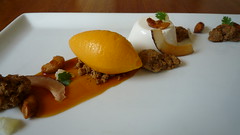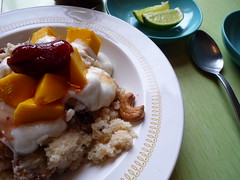Montreal Fruit Hunters' Local 24
With summer now in full effect, the Mile End/Outremont division of the Montreal Fruit Hunters' Association has been buzzing of late.
First, there was a wild mango tasting. It came hot on the heels of a trip by one of our members to the 21st annual International Mango Festival in Coral Gables, FL--the same festival depicted with such affection in Yung Chang's film version of The Fruit Hunters. Our intrepid colleague was gutsy enough to return with a suitcase full of rare breeds, and generous enough to share them with the rest of Local 24. Now that's a true Best Fruit Friend. (TY!)
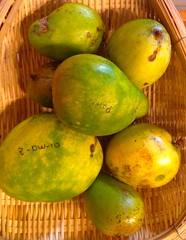 fig. a: these mangoes are wild
fig. a: these mangoes are wild
They were all different sizes and colours and most of them were marked with strange names like Z-DW-10, Poiri, and Zebda. They were varieties that had been collected around the world, then cultivated in Florida.
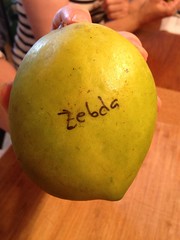 fig. b: Call me Ermenegildo.
fig. b: Call me Ermenegildo.
More importantly, they were wonderfully ripe, and perfumed to an extent some of the Local's members had never experienced before. The hot, muggy, July air seemed to agree with our specimens. The effect was enough to derange the senses.
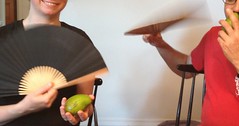 fig. c: the fruit sniffers
fig. c: the fruit sniffers
And then we started to portion them and eat them, and the experience was taken to the astral plane. Who knew mangoes could smell and taste like a crisp Chablis, like billowing frankincense, like a sweet, fatty piece of expertly spiced smoked meat? Apparently the range of flavours at the International Mango Festival ran even wider: banana cream pie; crème brûlée; marshmallow dust; and so on.
Some of the mangoes we sampled were sweet, while others were "savoury"--we imagined making the most wonderful ceviche with one particularly acidic variety, but they were still so good, so enticing, that we just went ahead and ate them right there and then anyway.
Our hands-down favourite was the Poiri, a variety that had all the fruitiness, all the sweetness, and all the fragrance one looks for in a top-notch Indian mango--only everything was amplified. It was like that mango had been turned up to 11. It also reminded me of that old line from Spenser for Hire (or was it A Man Called Hawk?): take the baddest mango you know; multiply it by two; add a few zeroes to that; and that doesn't even come close to how bad that Poiri was.
The moral of the story: there's a strange and beautiful world of mangoes out there. Seek them out when you're traveling in exotic tropical locales. Visit a mango festival, if you get the opportunity. And if you know someone who's planning on visiting a mango festival, beg them to bring a few back with them. You, too, might reach the astral plane.
-----
From the transnational, to the hyperlocal...
A day or two later, we were back at it. Local 24 had had such a great time devouring those mangoes, that we decided to reconvene to do a little urban foraging and clean an Outremont sour cherry tree of its highly prized fruit.
We considered renting an actual cherrypicker to do the job, but in the end all it took was a couple of tall ladders, some buckets, a little determination, and some nerves of steel.
 fig. d: cherrypickin'
fig. d: cherrypickin'
A couple of hours later we'd amassed a couple hundred dollars' worth of beautifully ripe fruit. So ripe, in fact, that you could almost eat them straight. Almost.
The very most perfect ones, we made sure to leave the stems on, we pricked each one ever so carefully three times with a sewing needle (as per Michelle's instructions), we placed them in jars, and we immersed them in a lethal combination of granulated sugar and Buffalo Trace Bourbon, then set them aside (for 30 days), in order to make Bourbon sour cherries. Mm-hmm.
The next most perfect ones we stemmed, pitted, and doused them with a little lemon juice, then placed them in a large Tupperware container so that Michelle would be able to make a sour cherry pie.
And the rest we stemmed, pitted, and mixed with a little bit of lemon juice and a lot of sugar, so that we could make sour cherry compote out of them and can them. We ended up with about twenty 250-ml jars of the sour cherry compote alone.
But the pièce de résistance was Michelle's pie.
 fig. e: cherry pie
fig. e: cherry pie
Michelle's got her own ways when it comes to sour cherry pie, but there are plenty of reliable recipes out there in the blogosphere, in newspapers and magazines (and their websites), and beyond. Alice Waters' instructions from Chez Panisse Fruit are particularly trustworthy, and that recipe is among the original inspirations for Michelle's own pie. Waters' introduction is sage, too. It highlights the urgency of the matter, as well as the proper method:
The season for tender, translucent, tiny, red sour cherries is only a few weeks long, so we buy as many as we can and make cherry pie as often as we can. We like to top them with lattice crusts so that plenty of steam can escape, allowing the filling to get nice and syrupy.
Respect is due.
Sour Cherry Pie
2 1/2 pounds sour cherries, stemmed and pitted (about 5 cups)
1 cup sugar
3 tbsp quick-cooking tapioca
1 tsp kirsch
two 9-oz pieces pie dough
2 tbsp heavy cream
1 tbsp unsalted butter
Preheat the oven to 400º F.
Toss the cherries with the sugar, tapioca, and kirsch. Let the fruit mixture macerate for 30 minutes--this will plump the tapioca and dissolve the sugar. Roll out the first piece of dough into a circle 1/8" thick. Line a 9" pie plate, leaving a 1/4"-wide overhang around the edges. Roll out the second piece of dough into a 13" circle; slide this onto a baking sheet and refrigerate. Pour the cherry mixture into the pie shell.
To make a lattice top, remove the second piece of dough from the refrigerator and cut into 1/2"-wide strips. Arrange half the strips on top of the pie, and 1/2" apart. Lay the remaining strips crisscross over the others (or, more prettily but more fussily, weave the strips [like Michelle did]). Trim all the strips of dough so that their overhang is no more than 1/4", and neatly fold the edge of the bottom crust over the strips. Pinch a wavy scalloped edge around the rim of the crust by making indentations with your thumb and fingers.
Brush the top with cream and sprinkle lightly with sugar. Dot the fruit exposed by the lattice with little pieces of cold butter (this step keeps the fruit from burning). Bake immediately (to prevent the crust from getting soggy) for about 45 minutes, placing the pie plate on a baking sheet so that the pie doesn't spill all over your oven, until the top crust is golden brown and thick juices are bubbling from the holes. Let the pie cool awhile on a rack before serving (it can be reheated in a warm oven for 10 minutes, if need be), and don't forget vanilla ice cream as an accompaniment and/or sweetened whipped cream.
Makes one 9" pie.
[based very, very closely on Alice Waters' recipe in Chez Panisse Fruit (2002)]But whatever recipe you choose to use, choose it quickly. As Waters points out, sour cherry season is notoriously short. If you're looking for the kinds of quantities you need to make pies here in Montreal, look for the buckets of fresh Montmorency cherries that come from Ontario. They're highly prized by local chefs, so you might have to place an order for one, but it's well worth your while. (Chez Nino at Marché Jean-Talon is an excellent source.)
Better yet, scout out a neighbourhood sour cherry tree and pick it clean. Just make sure to get the permission of the owner if it's on private property (like we did). Nine time out of ten you'll find that the owners will oblige you.
Trust me, fruit trees are out there, just begging to be picked. Most city folk don't seem to notice them, though--or, if they do, they seem to be under the bizarre impression that the fruit that grows on city trees is necessarily inedible. We got asked several times by passersby what it was that we were picking. "C'est des griottes," we told them. "Sour cherries."
One of these passersby was a woman who was taking a break from her job at a bakery. "Sour cherries? We make pastries with those inside."
Exactly.
Already, sour cherry pie is in the very highest ranks of down-home desserts. Sour cherry pie made with sour cherries that you picked yourself can be a downright epiphany.
aj
